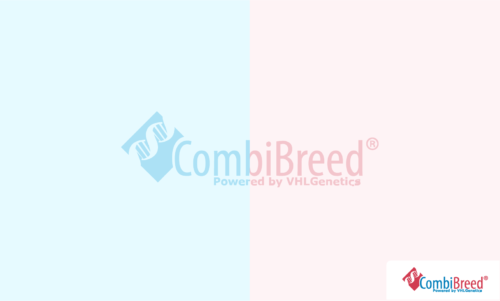Co-Locus Dog (Cocoa)
Chocolate or brown coat colour is fairly common in dogs. The most well know variant is the B-locus on the tyrosinase related protein 1 (TYRP1) gene. The mutations in TYRP1 gene are responsible for the dilution from black to brown. However, more recently (2020) it has been discovered that another brown variant exists in French Bulldogs; cocoa (co-locus). A mutation in the Hermansky-Pudlak Syndrome 3 (HPS3) gene disrupts the normal function of the HPS3 gene. The disruption leads to a reduction in the production in eumelanin, the type of pigment that produces black or brown colour. As a result a brown coat colour is present. The cocoa coat colour is often darker than other brown variants.
Affected dogs have a brown coat colour, referred to as cocoa, which is in adult dogs often slightly darker than the brown caused by B-Locus. Cocoa dogs may be born with blue eyes, though both coat and eye colour tend to darken into adulthood. Note that a dog can be affected by both the B-Locus and Cocoa mutations. However, interactions between cocoa en other brown variants are still not understood and therefore it is currently impossible to predict the phenotype of animals with both variants.
In human patients with Hermansky-Pudlak Syndrome 3, caused by a mutation to the same gene, bleeding disorders and visual impairments have been identified. It has not been investigated whether this is also applicable for cocoa coloured dogs.
Inheritance
The cocoa mutation is an autosomal recessive trait, meaning that dogs need two copies of the mutated allele to express cocoa coat colour.
| Genotype | Coat Colour* | Description |
|---|---|---|
| N?N | No cocoa, regular coat colour. | Cocoa allele not present. The basic colour is not modified. The dog can only pass on the unmutated allele N to its offspring. |
| N/co | No cocoa, regular coat colour. | Carrier of the cocoa variant. Phenotype is not present, so the dog will have a regular coat colour. 50% of the offspring will inherit a copy of the co-locus. |
| co/co | Cocoa brown coat, nose and footpads. | The cocoa phenotype is present. The display of this phenotype depends on the interaction between other colour genes (loci). 100% of the offspring will get a copy of the co-locus. |
*See additional information
Additional information
The expression of coat colours is influenced by many loci. This text only describes the effect of the Co-locus. Not all loci that cause brown mutations are known yet. Genotypes in other loci (like E-locus, K locus, B-locus, A-locus and D-locus) can influence the final phenotype as well. Be aware that an individual result can deviate because of these interactions and unknown effects.
Relevant tests
- H887
